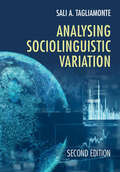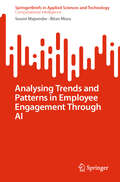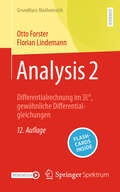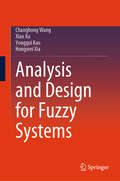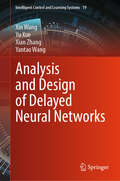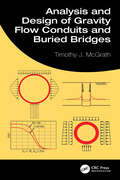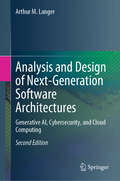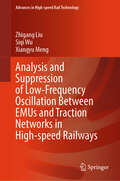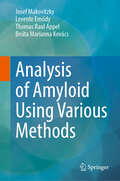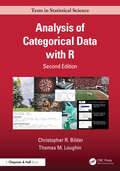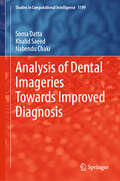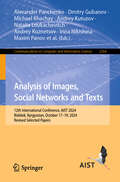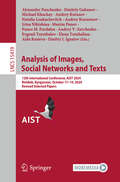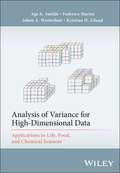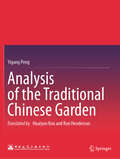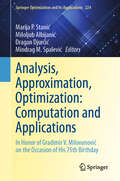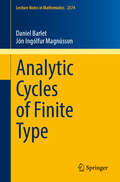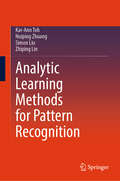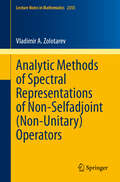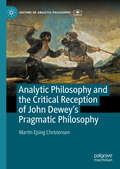- Table View
- List View
Analog Microelectronics
by Mattia BorgarinoThis textbook uses an innovative, fresh and rigorous approach to the analysis of analog circuits. The author guides students to leverage the psycho-cognitive concept of basic pattern as an efficient calculation tool, going beyond its traditional use for the qualitative visual inspection. In this journey, the reader is not left alone to face statements such as &“it is easy to prove that&” or &“it has been proven elsewhere that&”. All formulas and theorems are proven step-by-step. In particular, the proofs of the theorems on frequency response and stability have been made as intuitive as possible. The author thus demystifies and makes available to the student these relevant theorems, which are usually scattered over decades of reading and/or in several textbooks and papers. Two chapters focus on exercises of increasing difficulty, most of them discussed fully and solved step-by-step, allowing students to strengthen and test their knowledge. Moreover, the first two chapters introduce the history of microelectronics and physics of fundamental electron devices.
Analyses for Retaining walls, Slope Stability and Landslides: Select Proceedings of 8th ICRAGEE 2024 (Lecture Notes in Civil Engineering #568)
by Abhishek Kumar Rajib Sarkar B. K. MaheshwariThis book will present the select proceedings of the 8th International Conference on Recent Advances in Geotechnical Earthquake Engineering and Soil Dynamics (8ICRAGEE) held at the Indian Institute of Technology (IIT), Guwahati between December 11 and 14, 2024. It contains the latest research papers covering the contributions and accomplishments in geotechnical earthquake engineering and soil dynamics in the last four years. The five volumes of the book cover a wide range of topics, including but not limited to seismic hazard analysis, wave propagation and site characterization, dynamic properties and liquefaction of soils, pile foundations, offshore foundations, seismic design of retaining structures and dams, seismic slope stability and landslides, dynamic soil-structure interaction, seismic design of structures. Further, recent developments on these topics are covered in different chapters. This book will be valuable not only for researchers and professionals but also for drawing an agenda for future courses of action from the perspective of geotechnical earthquake engineering, keeping the national need at the forefront.
Analysing Museum Display: Theory and Method
by Christopher WhiteheadAnalysing Museum Display is the first comprehensive book to bring together approaches to studying museum displays. Drawing on global examples, it reviews different theoretical frameworks and methods, charting major contributions to the field and exploring their potentials and limitations.How and why should we study museum display, and what is its nature as a complex form of representation? The book argues that display is at once material, experiential, and political in producing knowledge and that analysis requires rigorous conceptualisation and careful methodologies. It provides a critical guide to existing concepts and methods, exploring how museum display can be understood using semiotic, narrative, cartographic, and spatial analyses, assemblage theory, new materialist and multisensory approaches, and theories of affect, emotion, and historical positioning. Alongside this, Whitehead presents key orientations for research practice relating to objectivity and subjectivity, historical and contextual awareness, and mixing methods.Analysing Museum Display will be essential reading for scholars and students of museology at all levels. The book will also appeal to museum curators and professionals who are involved in the production of displays and wish to develop a more theorised and reflective perspective on their own practice.
Analysing Sociolinguistic Variation
by Sali A. TagliamonteNow in its second edition, this is an invaluable manual for teaching and learning variation analysis, the quantitative study of linguistic variation and change. Written by a leading scholar in the field with over thirty years of experience, it provides an insider's view of the methodology through practical, 'hands-on' advice, including straightforward instructions for conducting analyses using the R programming language, the new gold standard for analysis. It leads readers through each phase of a research study based on data gathered in sociocultural contexts, beginning with the selection and sampling of a data source, to hints on successful project design, interview techniques, data management, analysis and interpretation, with systematic procedures provided at each step of the process. This edition has been fully updated, with new insights and explanations in line with recent discoveries in the field, making it essential reading for anyone embarking on their own sociolinguistic research project.
Analysing Trends and Patterns in Employee Engagement Through AI (SpringerBriefs in Applied Sciences and Technology)
by Soumi Majumder Bitan MisraThis book explores the concept of employee engagement, which is crucial for a company's success, as it is closely linked to job satisfaction and employee morale. Engaged workers tend to be more productive, efficient, and committed to the values and objectives of the company. Artificial intelligence plays a significant role in HR analytics, particularly in automating tedious tasks like data collection and organization from multiple sources. AI-driven employee engagement software can analyze employee feedback, surveys, and social media posts to capture the overall sentiment of the workforce. This allows HR teams to gain insights into employee experiences and perceptions, uncover areas for improvement, and address any issues that require attention. By leveraging past data and employing machine learning algorithms, AI enables HR professionals to predict turnover rates, forecast employee engagement levels, and identify potential flight risks.
Analysis 2: Differentialrechnung im ℝⁿ, gewöhnliche Differentialgleichungen (Grundkurs Mathematik)
by Otto Forster Florian LindemannDieses fest etablierte Lehrbuch begleitet Studierende der Mathematik, Physik und Informatik durch die Analysis des zweiten Semesters, genauer: durch die mehrdimensionale Differentialrechnung sowie die gewöhnlichen Differentialgleichungen. Bei der Darstellung wurden allzu große Abstraktionen vermieden, stattdessen wird die Theorie durch viele konkrete Beispiele erläutert – insbesondere solche, die für die Physik relevant sind. Jedes Kapitel enthält Übungsaufgaben zum Vertiefen der Inhalte. Für die vorliegende Auflage wurde der Text vollständig überarbeitet. Darüber hinaus ergänzen nun elektronische Flashcards das Buch: Diese per App zugänglichen Verständnisfragen unterstützen den Lernprozess und eignen sich auch sehr gut zur Prüfungsvorbereitung.
Analysis and Design for Fuzzy Systems
by Yonggui Kao Changhong Wang Hongwei Xia Xiao XuThis book proposes analysis and design techniques for fuzzy systems using adaptive technology, event triggering mechanism, sampling control technology, and sliding mode control technology. The book covers stochastic stability, finite-time boundedness, actuator failure problems, fault-tolerant control, asynchronous control, and adaptive sliding mode control for uncertain fuzzy systems. The topic of fault-tolerant control will be of particular interest to readers because: (i) the internal hardware components of the system may age and fail to a greater or lesser extent; (ii) the external environment may suddenly change. With illustrations and tables, readers can easily follow the didactic approach and apply the methods to their own research. This book will be of particular interest to researchers and graduate students in control engineering and applied mathematics who are interested in the latest developments in fuzzy systems.
Analysis and Design of Delayed Neural Networks (Intelligent Control and Learning Systems #19)
by Xin Wang Xian Zhang Yantao Wang Yu XueThis book provides a direct method based on system solutions to address the problems related to the analysis and control of delayed neural networks. The method proposed in this book is important for the following reasons: It does not involve the construct of any Lyapunov-Krasovskii functional (LKF), which overcomes the difficulty in constructing an appropriate and effective LKF; It can provide more simpler sufficient conditions, and hence it possesses less computational complexity; It can result in delay-dependent global exponential stability criteria that can used to give the decay rate estimation of the state; It is suitable for analysis and design problems of most system models with (multiple) delays after a small modification. The book is divided into 11 chapters, and focuses on the analysis and design problems related to delayed neural networks. It is written for graduate students and research level mathematicians and is suitable for postgraduates or as a reference.
Analysis and Design of Gravity Flow Conduits and Buried Bridges
by Timothy J. McGrathThis book covers the structural analysis and design of buried gravity flow conduits, including traditional pipes, arches, box conduits, and buried bridges with spans up to 80 ft (25 m) and greater. The text primarily covers concrete, corrugated metal, and plastic conduits but is generally applicable to other materials. Applications include culverts, storm drains, sewers, and pedestrian and vehicular crossings.The book is intended to introduce the subject to practitioners new to the field, as well as provide detailed information for those with prior experience. The opening chapter presents historical background and basic design models to introduce important concepts and then follows with chapters devoted to materials, soils, soil-conduit interaction, and guidance on the use of finite elements for analysis. Then design methods for evaluating soil-conduit systems are presented, along with guidance on important considerations during installation. The book concludes with field experiences of when things went wrong and why.Analysis and Design of Gravity Flow Conduits and Buried Bridges offers a unified and comprehensive guide for practicing engineers working on buried pipe design, private consultants, and product manufacturers, as well as researchers in the area.
Analysis and Design of Next-Generation Software Architectures: Generative AI, Cybersecurity, and Cloud Computing
by Arthur M. LangerThe 2nd edition will add a major chapter on Generative AI in Software Architecture. This chapter will provide a comprehensive background in generative models, its impact on software design, evolution of new analysis methodologies, and the overall impact of the Systems Development Life Cycle (SDLC). The new edition will also have new sections relating to Generative AI in Cybersecurity analysis and design, including proactive threat detection, ethical issues regarding privacy, and generative AI workflows (Charlotte AI). Other updates include Legacy System interfaces with Generative AI, new impacts on project management, and Platform design architecture. The 2nd edition will have a number of editing changes and corrections, as well as about 30 pages net of some eliminations of outdated content.
Analysis and Suppression of Low-Frequency Oscillation Between EMUs and Traction Networks in High-speed Railways (Advances in High-speed Rail Technology)
by Zhigang Liu Siqi Wu Xiangyu MengThis book focuses on the low-frequency oscillation between EMUs and traction networks in high-speed Railways. As the power source of high-speed trains, the traction network's power performance directly affects the safe and stable operation of the train. However, the low-frequency oscillation between EMUs and traction networks will fluctuate voltage or current, resulting in poor power quality, electrical device failure, and even interruption of traction power. Therefore, it is important to reveal the mechanism of low-frequency oscillation and propose suppression strategies. This book systematically shows the newest research results of analysis and suppression of low-frequency oscillation between EMUs and traction networks in high-speed railways, especially in the modeling methods of vehicle-grid systems and suppression strategies for low-frequency oscillation. These methods or strategies can provide important references and help for researchers, scholars, and engineers on traction power technology in high-speed railways. The main contents include the overview of low-frequency oscillation between EMUs and traction networks, the introduction of main modeling methods for vehicle-grid systems, especially single-phase rectifiers, the line-side converter control algorithms in vehicles for the suppression of low-frequency oscillation, the traction substation power compensation strategies for the suppression of low-frequency oscillation, etc.
Analysis of Amyloid Using Various Methods
by Josef Makovitzky Levente Emődy Thomas Raul Appel Beáta Marianna KovácsThis book explores the world of amyloid, consisting of heterogeneous deposits that have captivated scientists for decades. Amyloid, characterized by its highly organized insoluble protein fibrils exhibiting cross-layered quaternary beta-sheet structures, comprises diverse components such as the P-component, sialic acid, O-acyl sialic acid, and sGAG components. This assembly forms an anisotropic entity that induces birefringence in linearly polarized light, creating a distinctive optical signature. Initially linked to human disease and tissue damage, the predominant idea that amyloid only harms the host has been challenged. Recent pioneering studies have uncovered the existence of functional amyloid fibers in unexpected domains, from bacteria to mammals. Advances during the 1960s and 1970s, along with seminal immunohistochemical investigations, gave impetus to immunobiological analysis of amyloid in the 1980s. Notable work, such as the exploration of amyloid fiber staining techniques and the comprehensive study of histochemical properties, have enriched the understanding of this enigmatic deposit. The book presents a current overview of amyloid research in health and disease, with contributions from the prestigious biennial Amyloid Forum. Written by a distinguished researcher with nearly five decades of experience, the book encompasses five meticulously elaborated chapters. From human and animal deposits to bacterial formations, isolated fibrils, prions, and amyloid-related neurodegenerative disorders, each category of deposit is given a thorough examination. Innovative topo-optical staining techniques - polarization microscopy, fluorescence microscopy and confocal laser scanning fluorescence microscopy - reveal intricate structures in all species. Coherent structural features are authenticated by various staining reactions and different digestions. A key segment dissects animal prion fibers, revealing their intricate architecture by topo-optical reactions and uncovering selective arrangements of components. To complete this, the book confirms the postulated helical structure of the amyloid fiber. This innovative idea is validated by laser scanning confocal fluorescence microscopy, which reveals ordered and helically stacked amyloid protein fibrils in β-sheet conformation. Associations with chondroitin, heparan sulfate, and looser sphingolipid linkages further unravel the structural complexities of amyloid. Also offers an insightful journey into the realm of amyloid, combining historical knowledge with cutting-edge methodologies, redefining the understanding of this intricate phenomenon.
Analysis of Categorical Data with R (Chapman & Hall/CRC Texts in Statistical Science)
by Christopher R. Bilder Thomas M. LoughinAnalysis of Categorical Data with R, Second Edition presents a modern account of categorical data analysis using the R software environment. It covers recent techniques of model building and assessment for binary, multicategory, and count response variables and discusses fundamentals, such as odds ratio and probability estimation. The authors give detailed advice and guidelines on which procedures to use and why to use them.The second edition is a substantial update of the first based on the authors’ experiences of teaching from the book for nearly a decade. The book is organized as before, but with new content throughout, and there are two new substantive topics in the advanced topics chapter—group testing and splines. The computing has been completely updated, with the "emmeans" package now integrated into the book. The examples have also been updated, notably to include new examples based on COVID-19, and there are more than 90 new exercises in the book. The solutions manual and teaching videos have also been updated.Features: Requires no prior experience with R, and offers an introduction to the essential features and functions of R Includes numerous examples from medicine, psychology, sports, ecology, and many other areas Integrates extensive R code and output Graphically demonstrates many of the features and properties of various analysis methods Offers a substantial number of exercises in all chapters, enabling use as a course text or for self-study Supplemented by a website with data sets, code, and teaching videos Analysis of Categorical Data with R, Second Edition is primarily designed for a course on categorical data analysis taught at the advanced undergraduate or graduate level. Such a course could be taught in a statistics or biostatistics department, or within mathematics, psychology, social science, ecology, or another quantitative discipline. It could also be used by a self-learner and would make an ideal reference for a researcher from any discipline where categorical data arise.
Analysis of Dental Imageries Towards Improved Diagnosis (Studies in Computational Intelligence #1199)
by Khalid Saeed Nabendu Chaki Soma DattaThis book provides an insight on different types of hardware and software-based caries detection methods and their limitations from treatment perspective. The different chapters are motivated to address some of the important gaps in the prevailing approaches and suggest suitable solution to them. Overall, it helps the reader to understand the caries detection methods to identify interproximal and occlusal caries. This also assists the practitioners. The book identifies multiple research issues on dental caries detection that open the practitioners’ horizons to an array of domains from which they can conclude practical insights about their area of interest.
Analysis of Electric Machinery and Drive Systems (IEEE Press Series on Power and Energy Systems)
by Scott D. Sudhoff Oleg Wasynczuk Paul C. Krause Steven D. PekarekNew edition of the popular reference on machine analysis, focusing on reference frame theory with techniques for derivation of equations Analysis of Electric Machinery and Drive Systems covers the concepts needed to understand the evolution of electrical and magnetic variables for designing the power-electronic circuits that supply or extract electrical energy from a variety of machines, comprehensively addressing the varied needs of readers in the electric machinery, electric drives, and electric power industries. This fourth edition has been extensively revised and updated to include nine new or updated chapters on symmetrical three-phase stators, symmetrical induction machines, brushless DC machines, synchronous machines, neglecting electric transients, eigenvalues and voltage-behind-reactive machine equations, direct current machine and drive, and torque control of permanent-magnet and synchronous reluctance machines. Introductory concepts related to the subject have also been expanded upon, detailing stationary magnetically coupled circuits, energy balance relationships, energy in coupling field, and steady-state and dynamic performance of electromechanical systems. The fourth edition also includes illustrations of the free-acceleration characteristics of induction and brushless dc machines viewed from various reference frames and many other topics. With problems at the end of each chapter to reinforce learning, the book explores additional topics including: Operational impedances and time constraints of synchronous machines, covering Park’s equations in operational form and parameters from short-circuit and frequency-response characteristicsFully controlled three-phase bridge converters, covering six-step, sine-triangle, space-vector, hysteresis, and delta modulations, along with open- and closed-loop voltage and current regulationsMotor drives, covering volts-per-hertz, constant slip current, field-oriented, and direct torque control as well as slip energy recovery drives Brushless DC motor drives, covering average-value analysis, steady-state performance, and transient and dynamic performance of voltage-source inverter drives Analysis of Electric Machinery and Drive Systems, Fourth Edition, is a perfect resource for electrical engineering students and an essential, up-to-date reference for electrical and mechanical engineers working with drives.
Analysis of Images, Social Networks and Texts: 12th International Conference, AIST 2024, Bishkek, Kyrgyzstan, October 17–19, 2024, Revised Selected Papers (Communications in Computer and Information Science #2364)
by Panos M. Pardalos Dmitry Gubanov Andrey V. Savchenko Dmitry I. Ignatov Alexander Panchenko Michael Khachay Natalia Loukachevitch Andrey Kutuzov Elena Tutubalina Andrey Kuznetsov Evgenii Tsymbalov Irina Nikishina Maxim Panov Aida KasievaThis book constitutes the refereed proceedings of the 12th International Conference on Analysis of Images, Social Networks and Texts, AIST 2024, held in Bishkek, Kyrgyzstan, during October 17–19, 2024. The 12 papers included in this book were carefully reviewed and selected from 54 submissions. They were organized in topical sections as follows: natural language processing; computer vision; and data analysis and machine learning.
Analysis of Images, Social Networks and Texts: 12th International Conference, AIST 2024, Bishkek, Kyrgyzstan, October 17–19, 2024, Revised Selected Papers (Lecture Notes in Computer Science #15419)
by Panos M. Pardalos Andrey V. Savchenko Dmitry I. Ignatov Alexander Panchenko Michael Khachay Natalia Loukachevitch Andrey Kutuzov Elena Tutubalina Andrey Kuznetsov Evgenii Tsymbalov Irina Nikishina Maxim Panov Dmitriy Gubanov Aida KasievaThis book constitutes the refereed proceedings of the 12th International Conference on Analysis of Images, Social Networks and Texts, AIST 2024, held in Bishkek, Kyrgyzstan, during October 17–19, 2024. The 16 full papers included in this book were carefully reviewed and selected from 70 submissions. They were organized in topical sections as follows: Natural Language Processing; Computer Vision; Data Analysis and Machine Learning; and Theoretical Machine Learning and Optimization.
Analysis of Variance for High-Dimensional Data: Applications in Life, Food, and Chemical Sciences
by Age K. Smilde Kristian Hovde Liland Federico Marini Johan A. WesterhuisOverview of methods for analyzing high-dimensional experimental data, including theory, methodologies, and applications Analysis of Variance for High-Dimensional Data summarizes all the methods to analyze high-dimensional data that are obtained through applying an experimental design in the life, food, and chemical sciences, especially those developed in recent years. Written by international experts who lead development in the field, Analysis of Variance for High-Dimensional Data includes information on: Basic and established theories on linear models from a mathematical and statistical perspectiveAvailable methods and their mutual relationships, including coverage of ASCA, APCA, PC-ANOVA, ASCA+, LiMM-PCA and RM-ASCA+, and PERMANOVA, as well as various alternative methods and extensionsApplications in metabolomics, microbiome, gene expression, proteomics, food science, sensory science, and chemistryCommercially available and open-source software for application of these methods Analysis of Variance for High-Dimensional Data is an essential reference for practitioners involved in data analysis in the natural sciences, including professionals working in chemometrics, bioinformatics, data science, statistics, and machine learning. The book is valuable for developers of new methods in high dimensional data analysis.
Analysis of the Traditional Chinese Garden
by Yigang PengAnalysis of the Traditional Chinese Garden is a seminal resource for the spatial principles and techniques that shape traditional Chinese gardens. It is a richly illustrated resource for historians, theorists, garden designers, landscape architects, architects and anyone interested in the design of these world renowned gardens with 106 pages of hand-drawn sketches by the author that vividly portray the intricacies and subtleties of traditional Chinese gardens. The book is widely known in China as a primary text for analysis of the gardens and was recognized with the inaugural National Excellent Architectural Book Award in 1990 and, since its debut in China in 1986, has garnered immense popularity and acclaim with 50 reprints and a total print run of 150,000 copies.
Analysis, Approximation, Optimization: In Honor of Gradimir V. Milovanović on the Occasion of His 75th Birthday (Springer Optimization and Its Applications #224)
by Marija P. Stanić Miloljub Albijanić Dragan Djurčić Miodrag M. SpalevićThis contributed volume is dedicated to Academician Gradimir V. Milovanović on his 75th birthday and contains recent results in the fields of approximation theory, numerical analysis, mathematical analysis, optimization theory, and various applications of an interdisciplinary character. Most of these results were presented in person during an International Conference &“Analysis, Approximations and Applications" (AAA2023), organized by the Faculty of Science, University of Kragujevac in Vrnjačka Banja, Serbia (June 21-24, 2023). This book is intended for researchers and students of mathematics and other computational and applied sciences. This book provides surveys of state of the art results in the fields of Extremal Problems, Optimization and Calculus of Variations; Orthogonal Systems and Quadrature Formulas; Differential and Integral Equations, Integral Transforms and Operation Calculus; Analytic Number Theory and Special Functions; Real and Complex Functions, Sequences, Series, Approximations and Expansions; Functional Analysis, Operator Theory, Fixed Point Theory and Iterative Processes, as well as in Miscellaneous Applications.
Analysis, Design, and Construction Aspects of Geotechnical Structures: Select Proceedings of 8IYGEC 2021 (Lecture Notes in Civil Engineering #421)
by V. B. Maji M. Muttharam T. Thyagaraj P. T. Ravichandran G. Janardhanan S. BhuvaneshwariThis book presents the select proceedings of the 8th Indian Young Geotechnical Engineers Conference (8IYGEC 2021) on the following conference themes: Foundation Engineering, Rock Engineering, Slope Stability and Landslides and Deep Excavation and Underground Structures. The book covers a wide range of topics on foundation engineering that include analysis and performance of piled raft foundations, uplift capacity of helical and micro piles, and behaviour of anchor plates. The topics on slope stability and landslides include early warning system for landslides, landslide mitigation and simulation, rainfall induced landslide analysis and slope stability assessment of highway embankments, backfills, concave slopes, coal mine overburden dump and shallow footing on slope. Further, the various aspects of deep excavation and underground structures including the performance predictive models and ground response due to excavations, buried drainage pipe leakage, and urban metro tunnel construction are covered in this book. This book can be a valuable reference for academicians and practicing engineers.
Analytic Cycles of Finite Type (Lecture Notes in Mathematics #2374)
by Daniel Barlet Jón Ingólfur MagnússonThis book highlights the use of non-compact analytic cycles in complex geometry. The main focus is on analytic families of cycles of finite type, in other words, cycles which have only finitely many irreducible components. It is shown how the space of all cycles of finite type in a given complex space, endowed with a weak analytic structure, can be used in many ways as the reduced complex space of all compact cycles in the given space. Several illustrative and enlightening examples are provided, as well as applications, giving life to the theory. The exposition includes a characterization of quasi-proper holomorphic maps which admit a geometric flattening, a proof of an existence theorem for meromorphic quotients with respect to a large class of analytic equivalence relations, and a generalization of the Stein factorization to a variety of holomorphic maps. In addition, a study is made of the behavior of analytic families of finite type cycles when they are restricted to Zariski open subsets and extended across analytic subsets. Aimed at researchers and graduate students with an interest in complex or algebraic geometry, the book is adequately self-contained, the basic notions are explained and suitable references are given for auxiliary results that are used in the text.
Analytic Learning Methods for Pattern Recognition
by Kar-Ann Toh Huiping Zhuang Simon Liu Zhiping LinThis textbook is a consolidation of learning methods which comes in an analytic form. The covered learning methods include classical and advanced solutions to problems of regression, minimum classification error, maximum receiver operating characteristics, bridge regression, ensemble learning and network learning. Both the primal and dual solution forms are discussed for over-and under-determined systems. Such coverage provides an important perspective for handling systems with overwhelming samples or systems with overwhelming parameters. For goal driven classification, the solutions to minimum classification-error, maximum receiver operating characteristics, bridge regression, and ensemble learning represent recent advancements in the literature. In this book, the exercises offer instructors and students practical experience with real-world applications.
Analytic Methods of Spectral Representations of Non-Selfadjoint (Lecture Notes in Mathematics #2355)
by Vladimir A. ZolotarevThis book is concerned with the theory of model representations of linear non-selfadjoint and non-unitary operators. This booming area of functional analysis owes its origins to the fundamental works of M. S. Livšic on the theory of characteristic functions, the deep studies of B. S.-Nagy and C. Foias on dilation theory, and also to the Lax–Phillips scattering theory. Here, a uniform conceptual approach is developed which organically unites all these theories. New analytic methods are introduced which make it possible to solve some important problems from the theory of spectral representations. Aimed at specialists in functional analysis, the book will also be accessible to senior mathematics students.
Analytic Philosophy and the Critical Reception of John Dewey’s Pragmatic Philosophy (History of Analytic Philosophy)
by Martin Ejsing ChristensenThis book examines the critical reception of Dewey&’s pragmatic philosophy by six prominent analytic philosophers and relates it to the contested history of analytic philosophy and Deweyan pragmatism. It argues that analytic philosophers&’ critical reception of Dewey&’s pragmatist philosophy has, from the very beginning, been marred by externalist readings that do not engage with Dewey&’s thinking from the inside, and suggests that this throws doubt upon the new revisionary histories of analytic philosophy and Deweyan pragmatism according to which the marginalization of Dewey&’s pragmatism represents the sensible result of critical processes of reasoning. At the same time, however, the book also points out that Dewey and his analytic critics in fact share several worries and suggests that these common concerns might serve as points of reference for more fruitful dialogues across the traditions of analytic philosophy and Deweyan pragmatism in the future.



